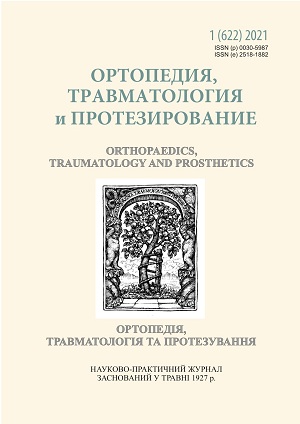Features of medical care in patientswith elbow joint gunshot wounds
DOI:
https://doi.org/10.15674/0030-5987202115-8Keywords:
Elbow joint, gunshot wounds, treatmentAbstract
Gunshot wounds of the elbow joint are the third most common after knee and shoulder injuries. Features of the anatomical and functional structure of the elbow joint, the close location of the vascular and nervous formations, favorable conditions for the development of infection determine the severity of gunshot wounds and cause the complexity of its treatment. Objective. To evaluate the frequency and nature of the elbow joint gunshot wounds in the structure of the general combat injuries, as well as to determine the volume of medical care and direction of treatment of such injuries in the conditions of the regional hospital as a stage of care. Methods. A retrospective study included 1 809 patients (96.0 % of men, mean age (33.7 ± 0.2) years). Firearms limb injuries were detected in 1 013 (56.0 %) of all victims, of which the elbow joint — 25 (2.47 %). Mines and explosives injuries were in 22 (88 %) of the patients, bullet — in 3 (12 %). Results. Tactics of treatment of elbow joint gunshot wounds depended on the severity of the condition of the victims and the nature of concomitant traumatic injuries. In the structure of combat injury of the elbow joint the majority was combined (52 %) and multiple (40 %) injuries and was accompanied by gunshot fractures in 60 %. In patients who were in severe state, applied the tactics of Damage control in two stages. At the first stage the fractures were fixed with plaster splints or external fixation devices (EF), the wounds were not subjected to full surgical debridment (SD), but only washed with antiseptics and the visible foreign bodies were removed. In patients with soft tissue injuries wounds the primary SD was performed according to general principles, injured nerves were not restored. In the second stage, after patient is stabilized, the repeated SD of the wound was performed. After their uncomplicated healing the EF was removed and the method of fixation was changed to internal osteosyntesis. Conclusions. It is recommended to perform stabilization of intra-articular gunshot fractures of the elbow joint with EF and after uncomplicated wound healing go to the internal osteosynthesis. Key words. Elbow joint, gunshot wounds, treatment.
References
- Bur’yanov, O. A., Komarov, M. P., & Likhodiy, V. V. (2015). Methodical development of classes to prepare students on the topic: “Gunshot wounds of the upper and lower extremities stream”. Chronicle of traumatology and orthopedics, 12, 3–32. [in Ukrainian]
- Akhmedov, B. A., & Tikhilov, R. M. (2008). Surgical treatment of intra-articular gunshot injuries of large joints of the extremities. Traumatology and Orthopedics of Russia, 2(48), 5–13. [in Russian]
- Borzykh, N. O., Strafun, O. S., & Vlasenko, M. O. (2018). Surgical treatment of the wounded with gunshot penetrating injuries of the elbow joint. Orthopedics, Traumatology and Prosthetics, 1(610), 29–33. https://doi.org/10.15674/0030-59872018129-33. [in Ukrainian]
- Aslanyan, S. A., Zarutsky, Ya. L., & Shudrak, A. A. (2015). Instructions on military field surgery: for the medical staff of the Armed Forces of Ukraine and other law enforcement agencies. Kyiv: Chalchynska N. V. [in Ukrainian]
- Stanely, D., & Trail, I. A. (2011). Operative Elbow Surgery: Expert Consult. Churchill Livingstone Elsevier
- Shapovalov, V. M., & Khominets, V. V. (2010). Possibilities of sequential osteosynthesis in the treatment of wounded with gunshot fractures of the long bones of the extremities. Genius of Orthopedics, 3, 5–12. [in Russian]
- Radchenko, O. M. (2016). Pathology of the heart associated with combat trauma: from the First World War to our times. Therapia. Ukrainian Medical Bulletin, 6(110), 46–48. [in Ukrainian]
- Loskutov, O. E., Zarutsky, Ya. L. (2018). Modern concept of diagnosis and treatment of gunshot and mine-explosive wounds of the extremities. Orthopedics, Traumatology and Prosthetics, 2, 57–62. https://doi.org/10.15674 / 0030-59872018257-62. [in Ukrainian]
Downloads
How to Cite
Issue
Section
License

This work is licensed under a Creative Commons Attribution 4.0 International License.
The authors retain the right of authorship of their manuscript and pass the journal the right of the first publication of this article, which automatically become available from the date of publication under the terms of Creative Commons Attribution License, which allows others to freely distribute the published manuscript with mandatory linking to authors of the original research and the first publication of this one in this journal.
Authors have the right to enter into a separate supplemental agreement on the additional non-exclusive distribution of manuscript in the form in which it was published by the journal (i.e. to put work in electronic storage of an institution or publish as a part of the book) while maintaining the reference to the first publication of the manuscript in this journal.
The editorial policy of the journal allows authors and encourages manuscript accommodation online (i.e. in storage of an institution or on the personal websites) as before submission of the manuscript to the editorial office, and during its editorial processing because it contributes to productive scientific discussion and positively affects the efficiency and dynamics of the published manuscript citation (see The Effect of Open Access).














